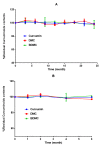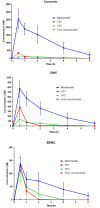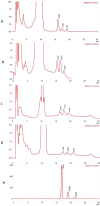Novel nanomicelle formulation to enhance bioavailability and stability of curcuminoids
- PMID: 31156789
- PMCID: PMC6528723
- DOI: 10.22038/ijbms.2019.32873.7852
Novel nanomicelle formulation to enhance bioavailability and stability of curcuminoids
Abstract
Objectives: Curcuminoids, comprising curcumin, demethoxycurcumin (DMC) and bisdemethoxycurcumin (BDMC), are bioactive phytochemicals with numerous pharmacological effects. Oral biological availability of curcuminoids is low due to the low aqueous solubility and rapid metabolism. This study aimed at fabricating a nanomicellar curcuminoid formula with enhanced pharmacokinetic properties.
Materials and methods: Curcuminoids nanomicelles were prepared and characterized regarding particle properties, stability, release profile and pharmacokinetic parameters.
Results: Encapsulation efficiency of curcuminoids in nanomicelles were 100%. Particle size analysis demonstrated a mean size of around 10 nm that remained stable for 24 months. Dissolution test showed the complete dissolution of encapsulated curcuminoids from nanomicelles within 20 min while the free curcuminoids were poorly dissolved (approximately 7% after 60 min). The results of long-term (24 months) and accelerated (6 months) stability studies showed no changes in the size and content of nanomicelles. The release studies in simulated gastric fluid (SGF) and simulated intestinal fluid (SIF) showed no release of curcuminoids for at least 4 hours. In vivo study in BALB/c mice showed improved pharmacokinetic parameters including maximum plasma concentration (Cmax) and time to reach the maximum concentration (Tmax) with nanomicelles as compared to free curcuminoids and two other commercial products. Tmax for all the three curcuminoid components was observed 30 min following oral administration. AUC of nanomicellar curcuminoids was 59.2 times more than free curcuminoids.
Conclusion: These data indicated that nanomicelles could improve solubility, oral bioavailability and also the stability of curcuminoids. Thus, they merit further investigation for enhancing pharmacological effects of curcuminoids.
Keywords: Biological availability; Curcuminoid; Drug stability; Micelle; Pharmacokinetics.
Conflict of interest statement
The authors report no declarations of interest.
Figures







Similar articles
-
The enhanced bioavailability of free curcumin and bioactive-metabolite tetrahydrocurcumin from a dispersible, oleoresin-based turmeric formulation.Medicine (Baltimore). 2021 Jul 9;100(27):e26601. doi: 10.1097/MD.0000000000026601. Medicine (Baltimore). 2021. PMID: 34232211 Free PMC article.
-
Determination of oral bioavailability of curcuminoid dispersions and nanoemulsions prepared from Curcuma longa Linnaeus.J Sci Food Agric. 2018 Jan;98(1):51-63. doi: 10.1002/jsfa.8437. Epub 2017 Jul 10. J Sci Food Agric. 2018. PMID: 28516478
-
Beyond Yellow Curry: Assessing Commercial Curcumin Absorption Technologies.J Am Coll Nutr. 2015;34(4):347-58. doi: 10.1080/07315724.2014.950392. Epub 2015 Apr 9. J Am Coll Nutr. 2015. PMID: 25856323 Free PMC article. Review.
-
Enhancement of curcumin oral absorption and pharmacokinetics of curcuminoids and curcumin metabolites in mice.Cancer Chemother Pharmacol. 2012 Mar;69(3):679-89. doi: 10.1007/s00280-011-1749-y. Epub 2011 Oct 4. Cancer Chemother Pharmacol. 2012. PMID: 21968952 Free PMC article.
-
Demethoxycurcumin: A naturally occurring curcumin analogue for treating non-cancerous diseases.J Cell Physiol. 2019 Nov;234(11):19320-19330. doi: 10.1002/jcp.28626. Epub 2019 Apr 4. J Cell Physiol. 2019. PMID: 31344992 Review.
Cited by
-
Application of ensemble machine learning approach to assess the factors affecting size and polydispersity index of liposomal nanoparticles.Sci Rep. 2023 Oct 21;13(1):18012. doi: 10.1038/s41598-023-43689-4. Sci Rep. 2023. PMID: 37865639 Free PMC article.
-
Stimulating effect of nanocurcumin and crocin on proliferation and pluripotency of bone marrow-derived mesenchymal stem cells.Iran J Basic Med Sci. 2024;27(9):1187-1196. doi: 10.22038/IJBMS.2024.74397.16197. Iran J Basic Med Sci. 2024. PMID: 39055876 Free PMC article.
-
Perspectives on nano-nutraceuticals to manage pre and post COVID-19 infections.Biotechnol Rep (Amst). 2022 Mar;33:e00712. doi: 10.1016/j.btre.2022.e00712. Epub 2022 Feb 11. Biotechnol Rep (Amst). 2022. PMID: 35186674 Free PMC article.
-
Nanomicellar curcuminoids attenuates renal ischemia/reperfusion injury in rat through prevention of apoptosis and downregulation of MAPKs pathways.Mol Biol Rep. 2021 Feb;48(2):1735-1743. doi: 10.1007/s11033-021-06214-2. Epub 2021 Feb 19. Mol Biol Rep. 2021. PMID: 33606150
-
In Vitro Inhibition of Xanthine Oxidase Purified from Arthritis Serum Patients by Nanocurcumin and Artemisinin Active Compounds.Molecules. 2023 Jun 29;28(13):5124. doi: 10.3390/molecules28135124. Molecules. 2023. PMID: 37446786 Free PMC article.
References
-
- Gupta SC, Kismali G, Aggarwal BB. Curcumin, a component of turmeric: from farm to pharmacy. Biofactors. 2013;39:2–13. - PubMed
-
- Prasad S, Gupta SC, Tyagi AK, Aggarwal BB. Curcumin, a component of golden spice: from bedside to bench and back. Biotechnol Adv. 2014;32:1053–1064. - PubMed
-
- Sahebkar A. Are curcuminoids effective C-reactive protein-lowering agents in clinical practice? Evidence from a meta-analysis. Phytother Res. 2014;28:633–642. - PubMed
-
- Panahi Y, Sahebkar A, Parvin S, Saadat A. A randomized controlled trial on the anti-inflammatory effects of curcumin in patients with chronic sulphur mustard-induced cutaneous complications. Ann Clin Biochem . 2012;49:580–588. - PubMed
LinkOut - more resources
Full Text Sources
